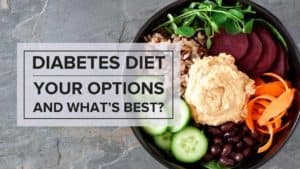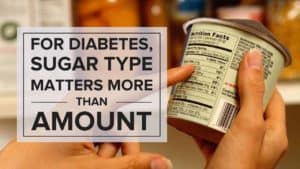
What Should Type 2 Diabetics Eat?
For people with type 2 diabetes, figuring out a healthy diet and food choices can be an uphill battle. In addition to having to adjust lifelong eating habits, there’s a great deal of conflicting information about what you can eat, what you should eat, and what you might want to eat.
We’ll try to offer a bit of a simplification. For most people with type 2 diabetes, the number one goal is to reverse insulin resistance, as this is the most surefire way to reverse type 2 diabetes and ensure that your pancreas is healthy in the long term.
Add in a secondary goal of maintaining healthy blood glucose (blood sugar levels) along the way, and the evidence points very clearly to one type of diet: a low-fat, plant-based, whole-food diet high in whole carbohydrates.
In this article, we’ll explain our research-backed approach for diabetes management (and reversal), which works well for type 1 diabetes management, prediabetes and type 2 diabetes, along with some of the principles behind how it works.
Then, we’ll touch on how this diet compares to the alternatives, and touch on a recommended meal plan and some tips for healthy eating.
Why Follow a Diabetes Diet?
A nutrient-poor diet is one of the most powerful contributors to diabetes risk, which can lead to comorbidities (associated diseases) like high blood pressure, high cholesterol levels, heart disease, and kidney disease.
Conversely, the low-fat, plant-based, whole-food diet that helps prevent diabetes (including insulin resistance and high blood glucose levels/hyperglycemia), also has other benefits, like weight loss, increased energy, increased immunity, and better physical fitness.
So it’s a win-win.
Type 2 Diabetes Food Breakdown
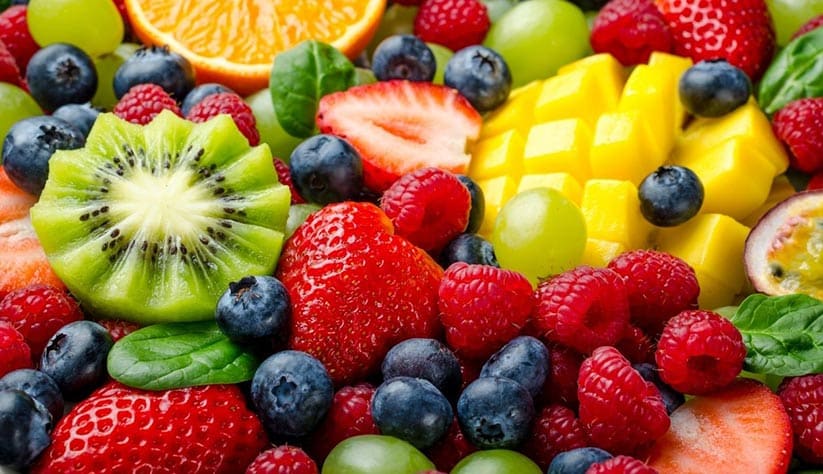
First and foremost, we recommend that the vast majority of your nutrients come from plants, due to the various risks associated with eating meat.
We also recommend removing artificial sweeteners and synthetic/processed products from your diet as much as possible, due to their proven association with chronic disease.
Finally, we recommend that you get 80+% of your calories from the carbohydrates found in whole-grains, fruits and berries, and vegetables, with the remaining calories coming from healthy fats and proteins.
Sound restrictive? You might think, but countless plant based recipes might make you rethink your food groups.
Carbohydrates
In recent years, carbohydrates have gotten a bad rap, mostly due to the presence of ‘bad’ carbohydrates. However, fruits, grains, and vegetables are rich in whole, natural carbohydrates, which are the foundation of a diabetes diet.
You can read more about the difference between these types of carbohydrates here.
What Are Good Carbs for Type 2 Diabetics to Eat?
Almost all plants, fruits, and vegetables are rich in good carbohydrates that you can eat ad libitum, meaning as much as you want without worrying about portion size.
In addition to being a great source of energy, they’re also high in nutrients like dietary fiber, antioxidants, and key vitamins.
These carbohydrate-rich foods (most of which are high-fiber) include:
What Carbs Should a Person with Diabetes Avoid?
The answer here is “simple”. No, literally, you should avoid simple carbohydrates, which include all processed and artificial sweeteners.
Keep an eye out and avoid:
Fats
We recommend a low-fat diet because dietary excess dietary fat is the primary cause of insulin resistance, the underlying condition that causes diabetes. Now, this doesn’t necessarily mean that you should remove all fat from your diet (which, in fact, is actually impossible).
Instead, focus on limiting your consumption of high fat foods.
What Are Good Fats for Type 2 Diabetics to Eat?
Foods like avocados, dates, durian, nuts and seeds, coconut meat, and soy products are all dense with healthy fats. Eaten in moderation, these foods won’t increase your insulin resistance, but can pose a risk in higher quantities.
One type of food that still has a bit of controversy around it is natural oils like olive oil. These oils are processed and high in fat, so you should be wary as to their effect on your overall health, but some research shows that in small, small quantities they can be healthy.
What Fatty Foods Should a Person with Diabetes Avoid?
In general, we recommend avoiding fat-rich foods if they fall into the 2 categories we recommend avoiding (artificial, or derived from meats).
This includes most saturated fats, trans fats, margarine, ghee and so on. They can be tasty, but the cardiovascular and health risks just aren’t worth it.
Protein
The research on high-protein diets is relatively clear: in most cases, you just don’t need that much protein, and if you’re not training hard and seeking to build muscle, these diets can actually increase your risk of disease significantly.
And while we may sound like a broken record, we recommend plant-based proteins, while avoiding most meats!
What Are Good Protein Sources for People with Type 2 Diabetes?
Plant-based proteins are the go-to, especially those from legumes and beans.
Some research, particularly on the Mediterranean diet, has begun to show that in small, small quantities some forms of meats like organ meats, as well as some varieties of fish and shellfish (mackerel, tuna, scallops, etc.) may not increase your risk as much as other meats.
However, if you’re looking for the fastest way to reverse insulin resistance and diabetes completely, plants are the way to go.
What Protein Should a Person with Type 2 Diabetes Avoid?
Processed meats and red meats are the big red flags here, with dairy products (even low-fat dairy) and most white meats filling out the list of foods to avoid. Though these foods can often be tasty, their long term risks just aren’t worth it, especially when trying to overcome diabetes.
The Best Type 2 Diabetes Diet
So what does the best type 2 diabetes diet look like? We break foods down into three categories: green light, yellow light, and red light foods.
Green lights you can eat as much as you want, period. Yellow lights are okay, but shouldn’t be daily staples. And we recommend removing red light foods from your diet and your pantry.
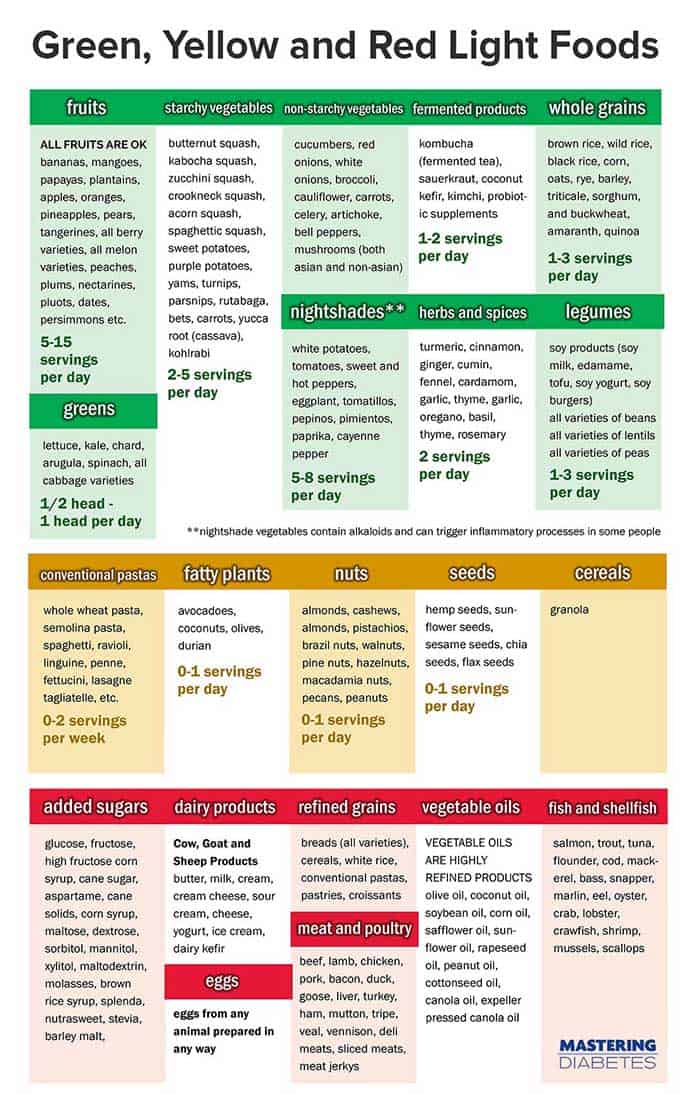
To learn more about this diet and how to execute it, you can check out our article on the diabetes diet, or talk to our coaches.
Other Type 2 Diabetes Eating Plans
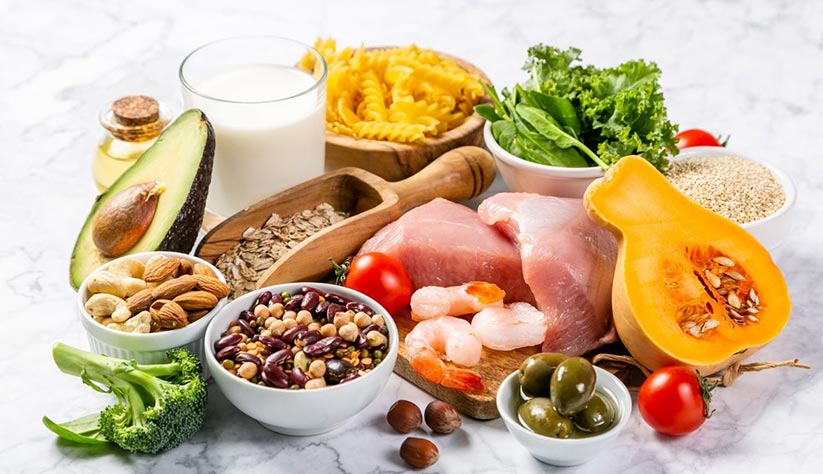
One of the main obstacles to diabetes care that we discussed before is that there’s a great deal of conflicting information out there about which diet is best for you. We’ll touch on a few here, including the principles behind them and where they may fall flat as a ‘diabetic diet’.
Of course, always work with your dietitian or diabetes health care provider to ensure that your team is on the same page about what you’re planning to eat.
Glycemic Index
The glycemic index is essentially a measure of how ‘energy dense’ specific foods are, based on how much they spike your blood glucose after consuming them. This can be a very helpful resource if you’re having trouble controlling your blood glucose and keeping it in range.
However, where the glycemic index falls a bit short in informing a diabetes diet is that it doesn’t acknowledge the tendency of different foods to cause insulin resistance and diabetes.
Final Word: A useful tool for informing blood glucose control, but not a method to base your eating schedule on.
Carbohydrate Counting
Carbohydrate counting, objectively, is simply counting the amount of carbohydrates in your diet compared to fats and proteins, which is not a bad thing. In fact, it can be a very helpful technique to make sure you’re eating a low-fat diet.
However, carbohydrate counting is often associated with trying to keep carbohydrates down, which is counterproductive to insulin resistance. As we’ve touched on, fats and proteins are some of the main culprits in causing insulin resistance.
Final Word: It’s not necessarily bad to count your carbohydrates, but we prefer focusing on the foods that you can happily eat in high quantities!
Mediterranean Diet
The Mediterranean Diet is modeled after the common breakdowns of plants, vegetables, fruits, seeds, oils, meats, and grains in traditional Mediterranean cultures.
Though exact definitions can vary, most common understandings of this diet place a heavy emphasis on plants and whole foods, with lean or fresh meats and seafoods on occasion.
Extensive studies of this diet have found that, especially compared to the Standard American Diet and diets high in processed foods and sugars, the Mediterranean Diet can be a powerful tool to combat diabetes, high cholesterol, high blood pressure, and risk of heart disease.
Final Word: In many ways, the Mediterranean diet is simply a less strict version of the low-fat, plant-based, whole-food diet, though they prioritize the same emphasis on whole carbohydrates, low-fats, and natural foods. A potential option once you’ve reversed insulin resistance.
Low-Carb Diet
The low-carb diet isn’t the worst possible diet that you can have if you’re suffering from diabetes, but in the long term it’s pretty bad for your overall health.
Though low-carb diets (which by definition are high in fat and protein) often have quick immediate results in terms of weight loss, better blood glucose, and better blood pressure, in the long term these diets are disastrous for your diabetes health.
Final Word: Don’t let the quick results fool you. Low-carb diets like keto, paleo, carnivore, and others are enticing, but don’t bode well for overall health.
Intermittent Fasting
Intermittent fasting is less of a dietary plan and more of an eating schedule, though when combined with a low-fat, plant-based, whole-food diet the results can be astounding.
The key here is a process called autophagy. When your body enters a period of fasting/calorie restriction, it recycles excess fats, proteins, and old cells, which helps with weight loss as well as immunity and overall health. Combined with the right diet, you’re set up for success.
Final Word: By itself, intermittent fasting is a potent tool, but when used in tandem with exercise and the right diet it can be a key to reversing insulin resistance fast.
Type 2 Diabetes Meal Plan
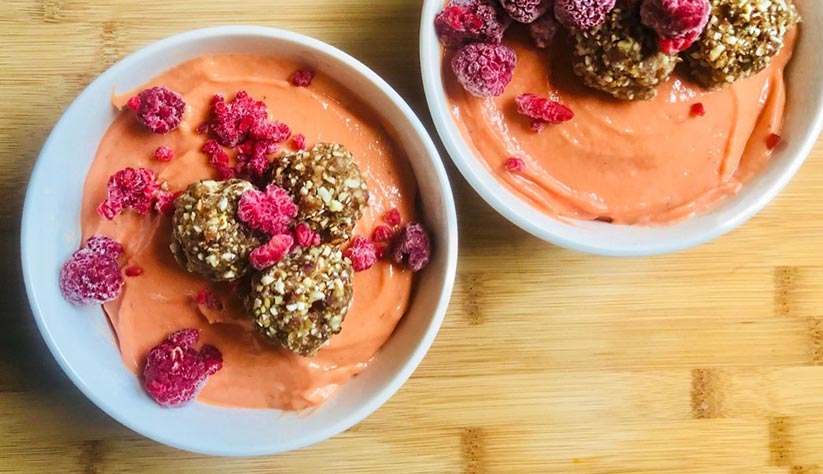
We know that one of the hardest parts of adjusting to a diabetes diet can be the feeling like you’re “giving up” a lot of your favorite foods.
That’s why we’ve put together a database of recipes for breakfast, lunch, dinner, desserts, and snacks that will make you feel like you’re not missing a beat! See how a week might look in our sample meal plan.
Header | Breakfast | Lunch | Dinner |
|---|---|---|---|
Day 1 | |||
Day 2 | |||
Day 3 | |||
Day 4 | |||
Day 5 | |||
Day 6 | |||
Day 7 |
You can reach out to our coaches if you’d like help putting together one of your own.
Healthy Eating Tips for People with Type 2 Diabetes

In addition to choosing the right diet, here are a few tips to stay on top of your eating plan, reverse diabetes, and avoid problems like chronic disease and weight gain.
Read Food Labels
A simple start to choosing healthy foods. In general, the less ingredients and the less complicated/scientific sounding the ingredients, the better, though there are always exceptions.
A good rule of thumb is that the food defaults to its lowest-level ingredient. So if you have six green-light ingredients, but one red-light, it’s best to search for alternatives.
Bonus points for natural fruits, plants, and vegetables that are so fresh they don’t even need a label!
Engage in Physical Activity
Another common sense suggestion, but one that can make a major difference! According to the American Diabetes Association (ADA), exercise is a fundamental part of diabetes treatment, and we’re big believers that it’s a fun and fulfilling part of our routine.
Not to mention the many, many, many other health benefits of exercise.
Get Expert Support
You don’t have to go it alone, especially if you’re just starting out. Meal planning is one of the most powerful tools to keep a diabetes diet fresh, fun, and healthy, but if you’re not used to the red-light green-light guidelines it can be hard to come up with recipes.
That’s where you can enlist the help of experts. Whether it’s working with a registered dietitian until you get the hang of a diet, teaming up with friends to swap recipes and cook together, or relying on diabetes educators like the experts at Mastering Diabetes, you can find support and guidance in any way you choose.
Stop Guessing What to Eat
Get Delicious Recipes Sent to Your Inbox Every Week!
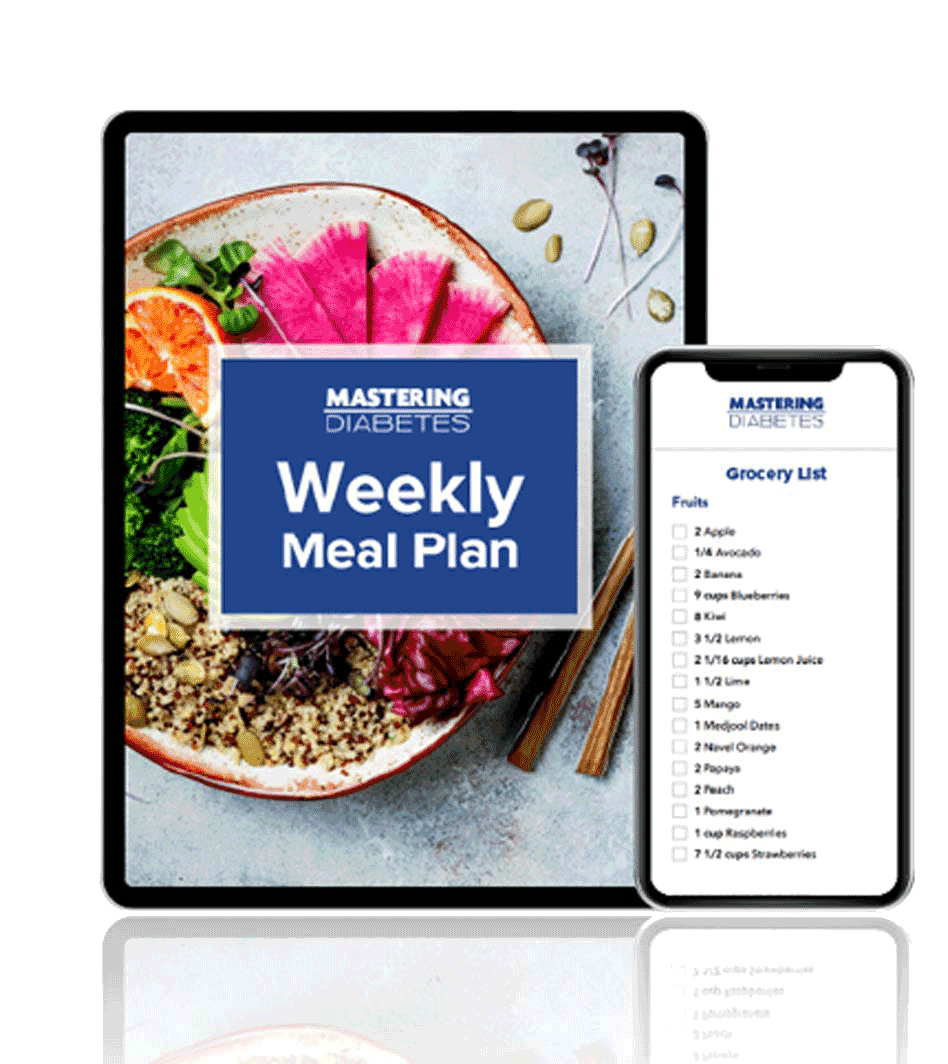
Discover the custom-designed Weekly Meal Plan that gives you clarity on what to eat and how to shop to simplify your journey to lower blood sugar, weight loss, and your best A1c


